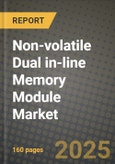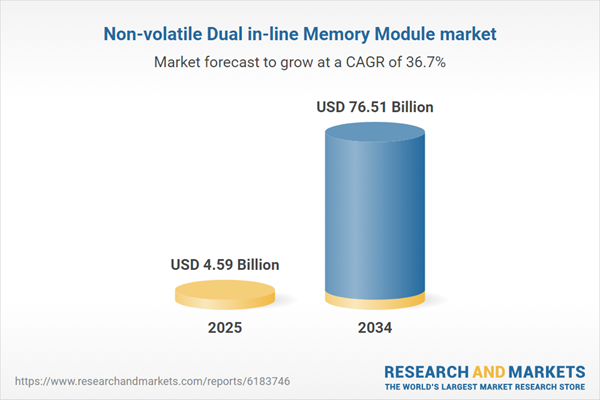Non-volatile Dual In-line Memory Module market
The Non-Volatile Dual In-line Memory Module (NVDIMM) market spans server-class memory modules that combine DRAM performance with non-volatile persistence - principally NVDIMM-N (DRAM + NAND with supercap backup), NVDIMM-F/P-like storage-class modules, and next-gen persistent memory form factors that expose byte- or block-addressable durability. Deployed in enterprise databases, in-memory analytics, high-frequency trading, virtualization, edge/5G cloud, and write-intensive logging, NVDIMMs safeguard volatile state through power loss while accelerating restart and checkpoint operations. Current trends include tighter CPU/memory controller enablement across server generations; OS and file-system features that exploit byte-addressable persistence; growth of write-ahead logging and caching tiers; and rising interest at the edge where limited UPS resiliency meets strict RTO/RPO targets. Competitive dynamics blend DRAM/NAND vendors, module houses, and platform OEMs; differentiation turns on sustained write endurance, firmware robustness, supercap reliability, thermal design, and out-of-band manageability. Barriers include cost versus conventional DRAM or NVMe SSD tiers, application refactoring to leverage persistence semantics, and supply chain variability for controller ASICs and capacitors. As architectures swing toward memory-centric computing, NVDIMMs evolve from niche “crash persistence” add-ons to platform features that compress I/O stacks, shrink failure domains, and deliver faster recovery and consistent latency for stateful services across core and edge data centers.Non-volatile Dual In-line Memory Module market Key Insights
- Uptime economics lead demand: Persistent memory cuts restart times for databases and in-memory grids, improving SLAs and maintenance windows; value is clearest where downtime monetizes poorly (trading, payments, ads, telco core).
- Hardware-software co-design wins: Platforms that pair BIOS/UEFI hooks, PMDK-class libraries, and journaling/log-structured data paths unlock byte-addressable performance without application brittleness.
- Endurance and data integrity are moats: Controller wear-levelling, power-loss protection, ECC/CRC end-to-end paths, and telemetry for media wear underpin trust, especially for 24/7 write bursts and hot logs.
- Thermals and form-factor pragmatism: Heat spreaders, airflow guidance, and supercap placement determine sustained writes and life; vendors with proven rack-level thermals suffer fewer derates in dense nodes.
- Tiering architectures mature: DRAM → NVDIMM → NVMe SSD hierarchies reduce tail latency for checkpointing and metadata while lowering DRAM footprint; orchestration tools automate placement.
- Edge and NEBs drive ruggedization: Short-depth servers and NEBS-style constraints favor shock/thermal tolerance, fast power-loss commits, and remote health telemetry for lights-out sites.
- Security by default: AES at rest, secure erase on decommission, firmware signing, and memory isolation features align with regulated workloads and multi-tenant clouds.
- Manageability at scale: BMC exposure of wear, temperature, and supercap health plus fleet APIs simplify SRE workflows; predictive replacement avoids surprise write throttling.
- Supply resilience matters: Second-source NAND/DRAM bins, supercap alternatives, and controller continuity guard against market shocks; vendors with stable AVL and LTB planning win OEM slots.
- TCO proof over benchmarks: Buyers prioritize SLA impact (fewer cold-starts, faster failover) and DRAM displacement savings rather than pure bandwidth metrics - ROI cases anchored in operations, not microbenchmarks.
Non-volatile Dual In-line Memory Module market Reginal Analysis
North America
Adoption is led by cloud, fintech, ad-tech, and enterprise analytics seeking fast recovery and deterministic write latency. Hyperscalers pilot memory-tiering with persistent modules to shrink DRAM footprints and accelerate checkpoint I/O. OEM qualifications emphasize telemetry, fleet manageability, and firmware resilience under live upgrades. Edge deployments in content delivery and 5G cores value power-loss protection and compact thermals; security features and supply continuity weigh heavily in awards.Europe
Financial services, industrial IoT hubs, and public-sector clouds adopt NVDIMMs to meet strict RTO/RPO and data-sovereignty needs. Procurement stresses standards compliance, secure firmware, and lifecycle transparency. Energy-conscious operators assess NVDIMM’s ability to cut DRAM wattage via tiering, alongside quick restart for planned maintenance. Telco and automotive back-ends explore ruggedized nodes and byte-persistent metadata to stabilize over-the-air update systems.Asia-Pacific
Large e-commerce, gaming, and super-app infrastructures drive write-intensive caching and session stores; data center builds pair NVDIMMs with NVMe fabrics to flatten I/O. Regional OEMs compete on cost-performance with strong platform enablement for the latest CPU generations. In Japan/Korea, NEBS-style telecom requirements and edge nodes favor high-reliability supercap systems; in China/SEA, price-performance and local supply chains are decisive.Middle East & Africa
National clouds, fintech, and growing telecom cores prioritize resilient state handling amid power variability. Buyers look for turnkey integration - qualified server SKUs, PSU and airflow validation, and remote health monitoring. Emerging edge sites for media and smart-city workloads value small-footprint servers with fast power-loss commits and strong security/erase features for multi-tenant environments.South & Central America
Regional banks, payment processors, and media/CDN operators adopt NVDIMMs to reduce outage risk and accelerate recovery in metros with constrained on-site power backup. Cost sensitivity drives careful TCO modeling - focus on SLA improvement, DRAM displacement, and simplified failover. Distributors with local spares, firmware support, and integration expertise help overcome skills gaps and validate benefits in mixed-vendor racks.Non-volatile Dual In-line Memory Module market Segmentation
By Product
- NVDIMM-N
- NVDIMM-F
- NVDIMM-P
By Capacity
- 8 GB
- 16 GB
- 32 GB and Above
By End-User
- Enterprise Storage and Server
- High-End Workstation
- Others
Key Market players
SMART Modular Technologies, Viking Technology, Micron Technology, Samsung Electronics, SK hynix, Netlist Inc., Innodisk, ADATA Technology, Apacer Technology, Transcend Information, Hewlett Packard Enterprise (HPE), Dell Technologies, Lenovo, AgigA Tech, SupermicroNon-volatile Dual In-line Memory Module Market Analytics
The report employs rigorous tools, including Porter’s Five Forces, value chain mapping, and scenario-based modelling, to assess supply-demand dynamics. Cross-sector influences from parent, derived, and substitute markets are evaluated to identify risks and opportunities. Trade and pricing analytics provide an up-to-date view of international flows, including leading exporters, importers, and regional price trends.Macroeconomic indicators, policy frameworks such as carbon pricing and energy security strategies, and evolving consumer behaviour are considered in forecasting scenarios. Recent deal flows, partnerships, and technology innovations are incorporated to assess their impact on future market performance.
Non-volatile Dual In-line Memory Module Market Competitive Intelligence
The competitive landscape is mapped through proprietary frameworks, profiling leading companies with details on business models, product portfolios, financial performance, and strategic initiatives. Key developments such as mergers & acquisitions, technology collaborations, investment inflows, and regional expansions are analyzed for their competitive impact. The report also identifies emerging players and innovative startups contributing to market disruption.Regional insights highlight the most promising investment destinations, regulatory landscapes, and evolving partnerships across energy and industrial corridors.
Countries Covered
- North America - Non-volatile Dual In-line Memory Module market data and outlook to 2034
- United States
- Canada
- Mexico
- Europe - Non-volatile Dual In-line Memory Module market data and outlook to 2034
- Germany
- United Kingdom
- France
- Italy
- Spain
- BeNeLux
- Russia
- Sweden
- Asia-Pacific - Non-volatile Dual In-line Memory Module market data and outlook to 2034
- China
- Japan
- India
- South Korea
- Australia
- Indonesia
- Malaysia
- Vietnam
- Middle East and Africa - Non-volatile Dual In-line Memory Module market data and outlook to 2034
- Saudi Arabia
- South Africa
- Iran
- UAE
- Egypt
- South and Central America - Non-volatile Dual In-line Memory Module market data and outlook to 2034
- Brazil
- Argentina
- Chile
- Peru
Research Methodology
This study combines primary inputs from industry experts across the Non-volatile Dual In-line Memory Module value chain with secondary data from associations, government publications, trade databases, and company disclosures. Proprietary modeling techniques, including data triangulation, statistical correlation, and scenario planning, are applied to deliver reliable market sizing and forecasting.Key Questions Addressed
- What is the current and forecast market size of the Non-volatile Dual In-line Memory Module industry at global, regional, and country levels?
- Which types, applications, and technologies present the highest growth potential?
- How are supply chains adapting to geopolitical and economic shocks?
- What role do policy frameworks, trade flows, and sustainability targets play in shaping demand?
- Who are the leading players, and how are their strategies evolving in the face of global uncertainty?
- Which regional “hotspots” and customer segments will outpace the market, and what go-to-market and partnership models best support entry and expansion?
- Where are the most investable opportunities - across technology roadmaps, sustainability-linked innovation, and M&A - and what is the best segment to invest over the next 3-5 years?
Your Key Takeaways from the Non-volatile Dual In-line Memory Module Market Report
- Global Non-volatile Dual In-line Memory Module market size and growth projections (CAGR), 2024-2034
- Impact of Russia-Ukraine, Israel-Palestine, and Hamas conflicts on Non-volatile Dual In-line Memory Module trade, costs, and supply chains
- Non-volatile Dual In-line Memory Module market size, share, and outlook across 5 regions and 27 countries, 2023-2034
- Non-volatile Dual In-line Memory Module market size, CAGR, and market share of key products, applications, and end-user verticals, 2023-2034
- Short- and long-term Non-volatile Dual In-line Memory Module market trends, drivers, restraints, and opportunities
- Porter’s Five Forces analysis, technological developments, and Non-volatile Dual In-line Memory Module supply chain analysis
- Non-volatile Dual In-line Memory Module trade analysis, Non-volatile Dual In-line Memory Module market price analysis, and Non-volatile Dual In-line Memory Module supply/demand dynamics
- Profiles of 5 leading companies - overview, key strategies, financials, and products
- Latest Non-volatile Dual In-line Memory Module market news and developments
Additional Support
With the purchase of this report, you will receive:- An updated PDF report and an MS Excel data workbook containing all market tables and figures for easy analysis.
- 7-day post-sale analyst support for clarifications and in-scope supplementary data, ensuring the deliverable aligns precisely with your requirements.
- Complimentary report update to incorporate the latest available data and the impact of recent market developments.
This product will be delivered within 1-3 business days.
Table of Contents
Companies Mentioned
- SMART Modular Technologies
- Viking Technology
- Micron Technology
- Samsung Electronics
- SK hynix
- Netlist Inc.
- Innodisk
- ADATA Technology
- Apacer Technology
- Transcend Information
- Hewlett Packard Enterprise (HPE)
- Dell Technologies
- Lenovo
- AgigA Tech
- Supermicro
Table Information
| Report Attribute | Details |
|---|---|
| No. of Pages | 160 |
| Published | November 2025 |
| Forecast Period | 2025 - 2034 |
| Estimated Market Value ( USD | $ 4.59 Billion |
| Forecasted Market Value ( USD | $ 76.51 Billion |
| Compound Annual Growth Rate | 36.7% |
| Regions Covered | Global |
| No. of Companies Mentioned | 15 |









